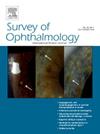Vitreous cortex remnants in patients with rhegmatogenous retinal detachment: A systematic review and meta-analysis
IF 5.9
2区 医学
Q1 OPHTHALMOLOGY
引用次数: 0
Abstract
The terminology “vitreous cortex remnants” (VCR) indicates the outermost lamellae of vitreous cortex that remains attached to the retinal surface as a consequence of vitreoschisis. The relevance of VCR removal in eyes with rhegmatogenous retinal detachment (RRD) is unknown. We conducted a review from January 1, 2000, to July 30, 2023, examining 1493 eyes. Outcome measures included: prevalence of VCR, relationship between VCR and detachment recurrence due to proliferative vitreoretinopathy (PVR), and relationship between VCR and epiretinal membrane (ERM) formation. A meta-analysis was performed with data reported as odds ratios (OR) or mean difference and 95 % confidence intervals. Prevalence of macular and peripheral VCR was 53.4 and 46.8, respectively, with an overall VCR prevalence of 50.8 (95 % CI 42.6, 59.1) Given the scarcity of available data, meta-analysis regarding the relationship between peripheral VCR and redetachment due to PVR was not feasible. The odds of developing ERM were not statistically different between eyes that had had macular VCR removal vs. eyes that had not (log OR −0.08 [95 % CI −1.06, 0.89 p= 0.89]. Additional prospective studies are required to verify whether removal of VCR may reduce the odds of recurrence of RRD due to PVR and the development of ERM.
流变性视网膜脱离患者的玻璃体皮质残留:系统回顾与元分析》。
玻璃体皮质残余物"(VCR)一词是指玻璃体裂孔后仍附着在视网膜表面的玻璃体皮质最外层。在流变性视网膜脱离(RRD)患者中去除 VCR 的意义尚不清楚。我们对 2000 年 1 月 1 日至 2023 年 7 月 30 日期间的 1493 只眼睛进行了回顾性研究。结果指标包括:VCR的患病率、VCR与增殖性玻璃体视网膜病变(PVR)导致的脱离复发之间的关系,以及VCR与视网膜上膜(ERM)形成之间的关系。荟萃分析以几率比(OR)或平均差和 95% 置信区间的形式报告数据。黄斑和周边 VCR 的患病率分别为 53.4 和 46.8,VCR 的总体患病率为 50.8 (95% CI 42.6, 59.1)。 由于可用数据稀少,因此无法就周边 VCR 与 PVR 引起的再脱落之间的关系进行荟萃分析。切除过黄斑 VCR 的眼睛与未切除 VCR 的眼睛发生 ERM 的几率没有统计学差异(log OR -0.08 [95% CI -1.06, 0.89 p=0.89])。需要进行更多的前瞻性研究,以验证切除 VCR 是否可以降低因 PVR 导致的 RRD 复发和 ERM 的发生几率。
本文章由计算机程序翻译,如有差异,请以英文原文为准。
求助全文
约1分钟内获得全文
求助全文
来源期刊

Survey of ophthalmology
医学-眼科学
CiteScore
10.30
自引率
2.00%
发文量
138
审稿时长
14.8 weeks
期刊介绍:
Survey of Ophthalmology is a clinically oriented review journal designed to keep ophthalmologists up to date. Comprehensive major review articles, written by experts and stringently refereed, integrate the literature on subjects selected for their clinical importance. Survey also includes feature articles, section reviews, book reviews, and abstracts.
 求助内容:
求助内容: 应助结果提醒方式:
应助结果提醒方式:


